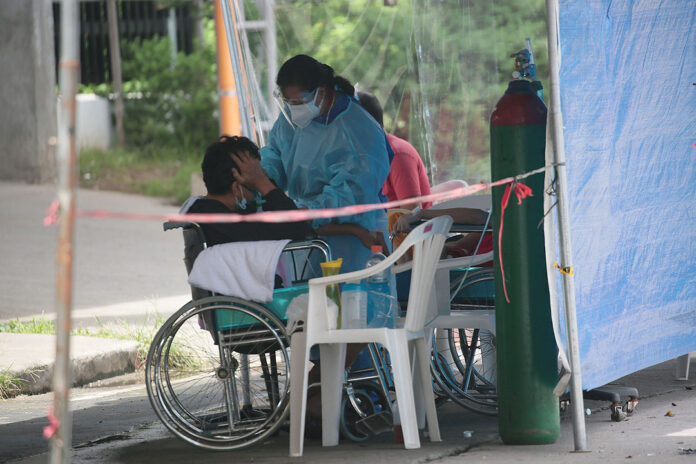A health worker attends to a patient outside a hospital in Quezon City, Aug. 29. — PHILIPPINE STAR/ MICHAEL VARCAS
THE PHILIPPINE economy’s rebound continues to be clouded by its “less effective” management of the coronavirus disease 2019 (COVID-19) outbreak, Moody’s Analytics said on Monday.
“The Philippines and Indonesia will struggle with less effective COVID-19 policies — vaccine shortages and ineffective social distancing measures — that create much uncertainty on the timing of a rebound,” Moody’s Analytics Chief Economist Steven Cochrane said in a note.
Based on the Relative COVID-19 Economic Risk Index released by Moody’s Analytics, the Philippines ranked near the bottom — 15th out of 20 economies in the Asia-Pacific region.
The index gauged the situation in Asia-Pacific economies based on the fully vaccinated as percentage of the population, new cases per million, and new deaths per million.
Singapore topped the index, followed by China, Cambodia, Hong Kong, and Japan. These countries are assessed to have the lowest relative economic risks from the ongoing pandemic.
The Philippines only fared better than Indonesia, Vietnam, Sri Lanka, Thailand, and Malaysia in the index.
According Moody’s Analytics, the Philippines ranked 13th in terms of the percentage of the population that has been fully vaccinated — which was at 12%.
The Philippines was also in 15th spot in terms of the 7-day moving average of new cases and new deaths per million.
The Health department on Monday reported a new record in daily COVID-19 infections at 22,366 and 222 additional deaths. Active COVID-19 cases stood at 148,594.
Moody’s Analytics also identified the Philippines as one of the countries that have seen the “most volatile” recovery paths this year.
“The Philippines, Malaysia, Singapore and Hong Kong have been the most volatile; each experienced a quarter-to-quarter decline of GDP in the second quarter of this year,” Mr. Cochrane said.
The economy exited recession in the second quarter after growing by 11.8%, mostly due to base effects. However, gross domestic product (GDP) declined by a seasonally adjusted 1.3% quarter on quarter in the April to June period, coming from the 0.7% growth in the first quarter.
Earlier this month, Moody’s Analytics downgraded its growth outlook for the Philippines to 4% from the 4.9% it gave in July due to the renewed restriction measures and limited government support.
Economic managers have also downgraded their full-year growth target to 4-5% from 6-7% previously, taking into account the economic cost of the two-week enhanced community quarantine earlier this month.
VACCINE ROLLOUT
In a separate note, Fitch Solutions Country Risk and Industry Research said the sluggish vaccine rollout in countries that have large population such as the Philippines, India, and Indonesia will hinder further economic reopening and a rebound in business activities.
Fitch Solutions said Indonesia, the Philippines, Thailand, and Malaysia are under “severe domestic health crises” caused by the more transmissible Delta variant.
“As a result, the risks of further outbreaks remain and the outlook for the region reopening in a meaningful way this year is remote,” Fitch Solutions said in a note on Monday.
Fitch Solutions has trimmed its growth forecast for the Philippines this year to 4.2%.
The government is still hoping to have 70% of the population fully vaccinated by the end of this year.
BSP BOOST NEEDED
Meanwhile, the recent strict lockdowns and a surge in COVID-19 cases continue to threaten recovery, which may prompt the central bank to ease monetary policy, according to a joint report by First Metro Investment Corp. (FMIC) and the University of Asia and the Pacific (UA&P) economists.
“We also think the Bangko Sentral ng Pilipinas (BSP) may ease slightly, likely through a reduction in reserve requirements, given the need to continue fueling the recovery,” they said on Monday.
The BSP retained key policy rates at a record low of 2% during the rate-setting meeting earlier this month but its chief Benjamin E. Diokno has said there is “no urgency” for the central bank to make drastic changes in the current monetary policy.
The same is true for the banks’ reserve requirement ratio (RRR) since the market remains awash with cash, he said, reassuring that the BSP will continue to support the economic recovery.
RRR of big banks is currently at 12%, following the central bank’s last cut in April 2020 with a 200-basis-point reduction.
Reserve requirements of thrift and rural banks stood at 3% and 2%, respectively.
FMIC and UA&P economists noted the economy’s improving growth prospects after promising GDP and manufacturing data. A sustained rebound in exports and imports should support a “brighter outlook” for the rest of the year until 2022, they added.
“The rise in COVID-19 cases due to the new variants, however, may still upend high hopes,” FMIC and UA&P economists said.
It is expecting the economy to grow at the lower end or slightly below its 5-6% projection for the year. — L.W.T.Noble and B.M.Laforga

